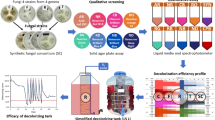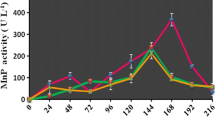Abstract
Textile dye effluents pose environmental hazards because of color and toxicity. Bioremediation of these has been widely attempted. However, their widely differing characteristics and high salt contents have required application of different microorganisms and high dilutions. We report here decolorization and detoxification of two raw textile effluents, with extreme variations in their pH and dye composition, used at 20–90% concentrations by each of the four marine-derived fungi. Textile effluent A (TEA) contained an azo dye and had a pH of 8.9 and textile effluent B (TEB) with a pH of 2.5 contained a mixture of eight reactive dyes. The fungi isolated from mangroves and identified by 18S and ITS sequencing corresponded to two ascomycetes and two basidiomycetes. Each of these fungi decolorized TEA by 30–60% and TEB by 33–80% used at 20–90% concentrations and salinity of 15 ppt within 6 days. This was accompanied by two to threefold reduction in toxicity as measured by LC50 values against Artemia larvae and 70–80% reduction in chemical oxygen demand and total phenolics. Mass spectrometric scan of effluents after fungal treatment revealed degradation of most of the components. The ascomycetes appeared to remove color primarily by adsorption, whereas laccase played a major role in decolorization by basidiomycetes. A process consisting of a combination of sorption by fungal biomass of an ascomycete and biodegradation by laccase from a basidiomycete was used in two separate steps or simultaneously for bioremediation of these two effluents.






Similar content being viewed by others
References
Ali N, Ikramullah, Lutfullah G, Hameed A, Ahmed S (2008) Decolorization of acid red 151 by Aspergillus niger SA1 under different physicochemical conditions. World J Microbiol Biotechnol 24:1099–1105. doi:10.1007/s11274-007-9581-6
APHA (2005) Standard methods for the examination of water and wastewater, 21st edn. American Public Health Association, Washington, DC
Baldrian P (2006) Fungal laccases-occurrence and properties. FEMS Microbiol Rev 30:215–242. doi:10.1111/j.1574-4976.2005.00010.x
Barahona-Gomariz MV, San-Barrera F, Sánchez-Fortún S (1994) Acute toxicity of organic solvents on Artemia salina. Bull Environ Contam Toxicol 52:766–771
Bartlett RE (1971) Wastewater treatment, public health engineering-design in metric. Applied Science Publishers, London
Blánquez P, Sarrá M, Vicent T (2008) Development of a continuous process to adapt the textile wastewater treatment by fungi to industrial conditions. Process Biochem 43:1–7. doi:10.1016/j.procbio.2007.10.002
Chung K-T, Stevens SE, Cerniglia CE (1992) The reduction of azo dyes by the intestinal microflora. Crit Rev Microbiol 18:175–190
Corso CR, de Almeida ACM (2009) Bioremediation of dyes in textile effluents by Aspergillus oryzae. Microbiol Ecol 57:384–390. doi:10.1007/s00248-008-9459-7
Crini G (2006) Non-conventional low-cost adsorbents for dye removal: a review. Bioresour Technol 97:1061–1085. doi:10.1016/j.biortech-2005.05.001
D’souza-Ticlo D, Tiwari R, Sah AK, Raghukumar C (2006) Enhanced production of laccase by a marine fungus during treatment of colored effluents and synthetic dyes. Enzyme Microbiol Technol 38:504–511. doi:10.1016/j.enzmictec.2005.07.005
D’souza-Ticlo D, Sharma D, Raghukumar C (2009) A thermostable metal-tolerant laccase with bioremediation potential from a marine-derived fungus. Mar Biotechnol (online). doi: 10.1007/s10126-009-9187-0
Damare S, Raghukumar C, Raghukumar S (2006) Fungi in deep-sea sediments of the Central Indian Basin. Deep-Sea Res Part I 53:14–27. doi:10.1016/j.dsr.2005.09.005
Dönmez G (2002) Bioaccumulation of the reactive textile dyes by Candida tropicalis growing in molasses medium. Enzyme Microbiol Technol 30:363–366. doi:S0141.0229(01)00511-7
Faraco V, Pezzella C, Giardina P, Sannia G (2009) Bio-remediation of colored industrial wastewaters by the white-rot fungi Phanerochaete chrysosporium and Pleurotus ostreatus and their enzymes. Biodegradation 20:209–220. doi:10.1007/s10532-008-9214-2
Ferrero F (2007) Dye removal by low cost adsorbents: hazelnut shells in comparison with wood sawdust. J Hazard Mater 142:144–152. doi:10.1016/j.jhazmat.2006.07.072
Fu Y, Viraraghavan T (2002) Dye biosorption sites in Aspergillus niger. Bioresour Technol 82:139–145. doi:S0960-8524(01)00172-9
Hai FI, Yamamoto K, Fukushi K (2007) Hybrid treatment system for dye wastewater. Cri Rev Environ Sci Technol 37:315–377. doi:10.1080/10643380601174723
Hao J, Song F, Huang F, Yang C, Zhang Z, Zheng Y, Tian X (2007) Production of laccase by a newly isolated deuteromycete fungus Pestalotiopsis sp. and its decolorization of azo dye. J Ind Microbiol Biotechnol 34:233–240. doi:10.1007/s10295-006-0191-3
Henriksson G, Johansson G, Pettersson G (2000) A critical review of cellobiose dehydrogenases. J Biotechnol 78:93–113. doi:10.1016/S0168-1656(00)00206-6
Hilden L, Johansson G, Pettersson G, Li J, Ljungquist P, Henriksson G (2000) Do the extracellular enzymes cellobiose dehydrogenase and manganese peroxidase form a pathway in lignin biodegradation? FEBS Lett 477:79–83. doi:10.1016/S0014-5793(00)01757-9
Jin XC, Liu GQ, Xu ZH (2007) Decolorization of a dye industry effluent by Aspergillus fumigatus XC6. Appl Microbiol Biotechnol 74:239–243. doi:10.1007/s00253-006-0658-1
Kim Y-J, Nicell JA (2006) Laccase-catalyzed oxidation of bisphenol A with the aid of additives. Process Biochem 41:1029–1037. doi:10.1016/j.procbio.2005.11.012
Kohlmeyer J, Kohlmeyer E (1979) Marine mycology. The higher fungi. Academic Press, New York
Kumar S, Masatoshi N, Dudley J, Tamura K (2008) MEGA: a biologistcentric software for evolutionary analysis of DNA and protein sequences. Brief Bioinf 9:299–306. doi:10.1093/bib/bbn017
Kunamneni A, Ghazi I, Cameraro S, Ballesteros A, Plou FJ, Alcalde M (2008) Decolorization of synthetic dyes by laccase immobilized on epoxy-activated carriers. Process Biochem 43:169–178. doi:10.1016/j.procbio.2007.11.009
Li X, Kondo R, Sakai K (2002) Studies on hypersaline-tolerant white-rot fungi. II. Biodegradation of sugarcane bagasse with marine fungus Phlebia sp. MG-60. J Wood Sci 48:159–162
Mishra G, Tripathy M (1993) A critical review of the treatment for decolorization of textile effluents. Colourage 40:35–38
Niku-Paavola ML, Karhuner E, Salola P, Raunio V (1988) Lignolytic enzymes of the white-rot fungus Phlebia radiata. Biochem J 254:877–884
Nyanhongo GS, Gomes J, Gubitz GM, Zvauya R, Read J, Steiner W (2002) Decolorization of textile dyes by laccase from a newly isolated strain of Trametes modesta. Water Res 36:1449–1456. doi:10.1016/S0043-1354(01)00365-7
Paszczynski A, Crawford RL, Huynh VB (1988) Manganese peroxidase of Phanerochaete chrysosporium: purification. Meth Enzymol 61:264–270
Pointing SB, Hyde KD (2000) Lignocellulose-degrading marine fungi. Biofouling 15:221–229. doi:10.1080/08927010009386312
Pointing SB, Vrijmoed LP, Jones EBG (1998) A qualitative assessment of lignocellulose degrading enzyme activity in marine fungi. Bot Mar 41:293–298
Prigione V, Tigini V, Pezella C, Anastasi A, Sannia G, Varese GC (2008a) Decolourisation and detoxification of textile effluents by fungal biosorption. Water Res 42:2911–2920. doi:10.1016/j.watres.2008.03.003
Prigione V, Varese GC, Casieri L, Filipello Marchisio V (2008b) Biosorption of simulated dyes effluents by inactivated fungal biomasses. Bioresour Technol 99:3559–3567. doi:10.1016/j.biortech.2007.07.053
Raghukumar C, Raghukumar S, Chinnaraj A, Chandramohan D, D’Souza TM, Reddy CA (1994) Laccase and other lignocellulose modifying enzymes of marine fungi isolated from the coast of India. Bot Mar 37:515–523
Raghukumar C, D’Souza TM, Thorn RG, Reddy CA (1999) Lignin modifying enzymes of Flavodon flavus, a basidiomycete isolated from a coastal marine environment. Appl Environ Microbiol 65:2100–2111
Raghukumar C, D’Souza-Ticlo D, Verma AK (2008) Treatment of colored effluents with lignin-degrading enzymes: an emerging role of marine-derived fungi. Crit Rev Microbiol 34:189–206. doi:10.1080/10408410802526044
Riu J, Schonse I, Barcelo D, Rafols C (1997) Determination of sulfonated azo dyes in water and wastewater. Trends Anal Chem 16:405–419. doi:10.1016/S0165-9936(97)00034-4
Rodríguez-Couto S, Osma JF, Toca-Herrera JL (2009) Removal of synthetic dyes by an eco-friendly strategy. Eng Life Sci 9:116–123. doi:10.1002/elsc.200800088
Senan RC, Abraham TE (2004) Bioremediation of textile azo dyes by aerobic bacterial consortium. Biodegradation 15:275–280. doi:10.1023/B:BIOD.0000043000.18427.0a
Singleton VL, Rossi JA Jr (1965) Colorimetry of total phenolics with phosphomolybdic–phosphotungstic acid reagents. Am J Enol Vitic 16:144–158
Thompson JD, Gibson TJ, Plewniak F, Jeanmougin F, Higgins DG (1997) The clustal_X windows interface: flexible strategies for multiple sequence alignment aided by quality analysis tools. Nucleic Acid Res 25:4876–4882
Tien M, Kirk TK (1988) Lignin peroxidase of Phanerochaete chrysosporium. Meth Enzymol 161:238–249
Tsuge H, Natsuaki O, Ohashi K (1975) Purification, properties and molecular features of glucose oxidase from Aspergillus niger. J Biochem 78:835–843
Wesenberg D, Buchon F, Agathos SN (2002) Degradation of dye-containing textile effluent by the agaric white-rot fungus Clitocybula dusenii. Biotechnol Lett 24:989–993. doi:18225.5400010869742.0070
Wesenberg D, Kyriakides I, Agathos SN (2003) White-rot fungi and their enzymes for the treatment of industrial dye effluents. Biotechnol Adv 22:161–187. doi:10.1016/j.biotechadv.2003.08.011
White TJ, Bruns TD, Lee SB, Taylor JW (1990) Amplification and direct sequencing of fungal ribosomal RNA genes for phylogenetics. In: Innis N, Gelfand D, Sninsky J, White TJ (eds) PCR-protocols and applications—a laboratory manual. Academic Press, New York, pp 315–322
Wong Y, Yu J (1999) Laccase-catalyzed decolorization of synthetic dyes. Water Res 33:3512–3520. doi:10.1016/S0043-1354(99)00066-4
Xia X, Xie Z (2001) Dambe: software packages for data analysis in molecular biology and evolution. J Hered 92:371–373
Zümriye A, Karabayir G (2008) Comparison of biosorption properties of different kinds of fungi for removal of Gryfalan Black RL metal-complex dye. Biores Technol 99:7730–7741. doi:10.1016/j.biortech.2008.01.056
Acknowledgments
The corresponding author (CR) wishes to thank Department of Biotechnology (DBT), New Delhi for the research grant BT/PR5637/BCE/08/379/2004. The first author (AV) is thankful to DBT, New Delhi for the award of junior research fellowship. The first two authors acknowledge the encouragement and support of Dr. Satish Shetye, Director, National Institute of Ocenography. Atul Pvt. Ltd, Gujarat is acknowledged for the effluent samples. NIO’s contribution No. 4610.
Author information
Authors and Affiliations
Corresponding author
Electronic supplementary material
Below is the link to the electronic supplementary material.
Rights and permissions
About this article
Cite this article
Verma, A.K., Raghukumar, C., Verma, P. et al. Four marine-derived fungi for bioremediation of raw textile mill effluents. Biodegradation 21, 217–233 (2010). https://doi.org/10.1007/s10532-009-9295-6
Received:
Accepted:
Published:
Issue Date:
DOI: https://doi.org/10.1007/s10532-009-9295-6




